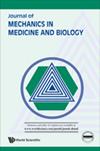APPLICATION AND ANALYSIS OF CUSTOMIZED BONE GRAFT OF A PATIENT UNDERGOING MANDIBLE AUGMENTATION AND DENTAL IMPLANTATION
IF 0.6
4区 医学
Q4 BIOPHYSICS
引用次数: 0
Abstract
The mandibular bone may be damaged for a variety of reasons. One of the methods used to facilitate and stimulate the bone to improve hard tissue formation is the use of bone grafts. In this study, a novel methodology was introduced to take a step towards making a custom xenograft for a patient with a mandibular bone defect. The application of the finite element method and evaluation of the graft simulation results was proposed, then the customized xenograft was provided using micro-milling. Also, 3D printing technology was used as a preoperative assessment of bone-graft interface conformity. Afterward, the graft was implemented for mandibular augmentation and the patient was prepared for further dental implantation. Finally, cone-based computer tomography images in different time intervals were taken for clinical assessment. Results showed that six months after the graft placement, the vertical distance from the alveolar ridge to the incisive canal and the mandibular canal was increased by 261% and 250%, respectively. Furthermore, the images taken after the insertion of dental implants and frequent observations by the dental surgeon approved the success of the treatment. Additionally, several quantitative parameters were compared to and established with the previous literature. Combining the conventional clinical examination method with an initial computational simulation by the criteria proposed in this study aided in predicting the success of mandibular augmentation and the subsequent dental implantation. More numerical analysis criteria can be added and assessed in future studies to improve the proposed method.定制骨移植在下颌隆牙种植患者中的应用与分析
下颌骨可能因各种原因而受损。用于促进和刺激骨骼以改善硬组织形成的方法之一是使用骨移植物。在这项研究中,介绍了一种新的方法,采取了一步,使定制异种移植物的病人下颌骨缺损。提出了有限元方法的应用和接枝仿真结果的评价,并利用微铣削技术提供了定制的异种接枝。此外,3D打印技术被用于骨移植界面一致性的术前评估。之后,移植物实施下颌隆胸,并为患者准备进一步种植。最后,采集不同时间间隔的ct图像进行临床评估。结果显示,植牙6个月后,牙槽嵴到牙槽管和下颌管的垂直距离分别增加了261%和250%。此外,植入牙种植体后拍摄的图像和牙科医生的频繁观察证实了治疗的成功。此外,我们还与先前的文献进行了一些定量参数的比较和建立。将传统的临床检查方法与本研究提出的标准的初始计算模拟相结合,有助于预测下颌隆牙和后续种植的成功。在未来的研究中,可以增加更多的数值分析准则来改进所提出的方法。
本文章由计算机程序翻译,如有差异,请以英文原文为准。
求助全文
约1分钟内获得全文
求助全文
来源期刊

Journal of Mechanics in Medicine and Biology
工程技术-工程:生物医学
CiteScore
1.20
自引率
12.50%
发文量
144
审稿时长
2.3 months
期刊介绍:
This journal has as its objective the publication and dissemination of original research (even for "revolutionary concepts that contrast with existing theories" & "hypothesis") in all fields of engineering-mechanics that includes mechanisms, processes, bio-sensors and bio-devices in medicine, biology and healthcare. The journal publishes original papers in English which contribute to an understanding of biomedical engineering and science at a nano- to macro-scale or an improvement of the methods and techniques of medical, biological and clinical treatment by the application of advanced high technology.
Journal''s Research Scopes/Topics Covered (but not limited to):
Artificial Organs, Biomechanics of Organs.
Biofluid Mechanics, Biorheology, Blood Flow Measurement Techniques, Microcirculation, Hemodynamics.
Bioheat Transfer and Mass Transport, Nano Heat Transfer.
Biomaterials.
Biomechanics & Modeling of Cell and Molecular.
Biomedical Instrumentation and BioSensors that implicate ''human mechanics'' in details.
Biomedical Signal Processing Techniques that implicate ''human mechanics'' in details.
Bio-Microelectromechanical Systems, Microfluidics.
Bio-Nanotechnology and Clinical Application.
Bird and Insect Aerodynamics.
Cardiovascular/Cardiac mechanics.
Cardiovascular Systems Physiology/Engineering.
Cellular and Tissue Mechanics/Engineering.
Computational Biomechanics/Physiological Modelling, Systems Physiology.
Clinical Biomechanics.
Hearing Mechanics.
Human Movement and Animal Locomotion.
Implant Design and Mechanics.
Mathematical modeling.
Mechanobiology of Diseases.
Mechanics of Medical Robotics.
Muscle/Neuromuscular/Musculoskeletal Mechanics and Engineering.
Neural- & Neuro-Behavioral Engineering.
Orthopedic Biomechanics.
Reproductive and Urogynecological Mechanics.
Respiratory System Engineering...
 求助内容:
求助内容: 应助结果提醒方式:
应助结果提醒方式:


